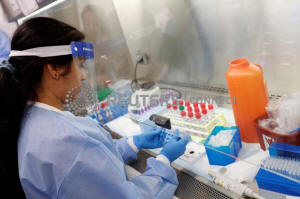U.S. hospitals promise new safety measures to ease patient fears after
coronavirus crush
 Send a link to a friend
Send a link to a friend
 [May 02, 2020]
By Deena Beasley and Gabriella Borter [May 02, 2020]
By Deena Beasley and Gabriella Borter
(Reuters) - U.S. hospitals, many past the
peak coronavirus crush, are relying on plexiglass dividers, advance
testing of patients and limited elevator traffic to convince people,
especially those needing urgent care, that the facilities are safe.
Hospitals put lucrative elective procedures and other nonessential
operations on hold weeks ago as they geared up for the coronavirus
onslaught.
But fear of the highly contagious virus, which has killed over 63,000
people and infected more than one million in the United States, has kept
even victims of serious health crises like stroke and appendicitis away
from emergency rooms.
"We have to convey to the public that we are safe ... and to defer
medical care in urgent situations will cause more harm," said Mark
Solazzo, chief operating officer at Northwell Health, New York's largest
healthcare provider.
In addition to urgent care, medical providers are beginning to tell
patients they can come back for more routine care, and are spelling out
new precautions they are taking in order to regain the public's trust.

Efforts put in place due to the pandemic - like screening people for
symptoms of COVID-19 - the illness caused by the coronavirus - taking
the temperature of everyone entering a healthcare facility, making
people wear masks, and supplying disinfectant wipes, will continue.
Hospitals will still rely heavily on “telemedicine” visits by video chat
to help triage patients and determine whether they need to be seen.
Patients are automatically tested for coronavirus infection before they
are admitted for scheduled surgery or other inpatient procedures.
Northwell and other hospital systems have launched marketing campaigns
to explain how they are making visits safer.
In an email sent to nearly 3 million New York area residents, Northwell
reminds patients that visitors are not allowed at its hospitals, that
all staff wear full protective gear, and that patients can wait in the
parking lot and check in to appointments on their phone to avoid waiting
room crowds. Plexiglass barriers are being used in reception areas to
separate patients from office staff and the health system plans to share
information about how facilities are being deep-cleaned.
UCHealth, Colorado's largest health system, is limiting elevator
capacity, normally around a dozen people, to four at a time, and is
asking them to maintain their distance, with one person in each corner.
To avoid sharing pens, UCHealth urges patients to fill out their
paperwork online ahead of a visit.
RISK OF DELAYED CARE
U.S. hospitalization rates fell in March compared to February for a
range of critical conditions, according to claims statistics from health
insurer Cigna Corp <CI.N>.
[to top of second column]
|

A medical technologist tests a respiratory panel at Northwell Health
Labs, where the same test will be used on the COVID-19, the disease
caused by the novel coronavirus, after being authorized to begin
semi-automated testing by the US Food and Drug Administration (FDA)
in Lake Success, New York, U.S., March 11, 2020. REUTERS/Shannon
Stapleton/File Photo

Downturns ranged from 11% for acute coronary syndromes such as heart
attack, to over 30% for patients experiencing stroke or irregular
heartbeat. For a stroke, getting to the hospital very quickly is
critical to recovery chances.
U.S. medical tests for detecting and monitoring cancer and other
conditions fell by as much as 68% in mid-March through mid-April,
according to a report from Komodo Health.
Several recent stroke patients at Hoag Hospital in Newport Beach,
California had delayed care for days after their first symptoms,
citing fear of the virus, Dr. Michael Brant-Zawadzki, the hospital's
senior physician executive, told Reuters.
One young man experienced weakness due to a rare lesion in his
brain, but did not come to the hospital until he was paralyzed on
one side. In another case, an elderly man had an acute stroke, but
put off going to the hospital because he is in a high risk category
for contracting the coronavirus. Both patients now have brain
damage.
Cedars-Sinai Medical Center in Los Angeles is emailing patients to
assure them that people diagnosed with COVID-19 are kept separate
from the general hospital population, that staff members are
screened daily and that everyone is required to wear face masks.
"We are encouraging people to seek urgent care. We still have the
capacity," said Dr. Richard Riggs, chief medical officer at
Cedars-Sinai.
Hospitals are redesigning waiting rooms to space out seating, which
in some cases is being replaced with furniture made of easy-to-clean
materials.

"It is important that we don't see ongoing delay of care. We worry
about the escalation of chronic disease," Dr. Robert Hart, chief
medical officer at Ochsner Health, Louisiana's largest hospital
system, said in a phone briefing.
Ochsner is determining how to reschedule surgeries put on hold
during the crisis in order to avoid "doing more harm than good," he
said.
(Reporting By Deena Beasley in Los Angeles and Gabriella Borter in
New York, Editing by Michele Gershberg and Bill Berkrot)
[© 2020 Thomson Reuters. All rights
reserved.] Copyright 2020 Reuters. All rights reserved. This material may not be published,
broadcast, rewritten or redistributed.
Thompson Reuters is solely responsible for this content. |